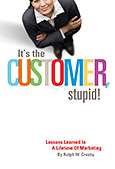Sob Stories Inspire Actions That Matter
Lecturing recently to a group of Johns Hopkins University Master’s degree students, I hit a nerve when I told them that communications content will resonate best with the audience if it is emotional, e.g., funny, sad or shocking.
These communications students responded with questions about my specific examples such as Crosby’s campaign to increase the number of registered organ donors. They asked if it was sadness or hope that moved people to action in this case. My answer was: “inspirational.”
The program inspired an action that matters, which happens to coincide with Crosby’s company mantra.
I discovered this emotional effect as a journalist many years ago. In my newspaper days, I often noticed how an emotional story would move people to action. Some would literally make people cry. (That’s where we get the term “sob story,” usually an account of personal troubles that is meant to arouse sympathy.)
I once wrote a sob story about a poor family’s tragedy that left them penniless and, shortly after it appeared in the paper, I received a pile of mail in which I discovered cash and checks made out to me to give to the family.
I realized then that the best way to move people to action was by appealing to their feelings. I discovered that sending messages could be related to the ancient maxim that people are motivated by both positive and negative emotions – such as love and kindness, fear and greed.
My intuitive discovery has been backed up by behavioral research. Behavioral scientists studying the brain have debunked the idea that decisions are made mostly through logical, linear thinking. They discovered that emotions are critical in retaining and retrieving messages. In a landmark study by the American Association of Advertising Agencies, this finding was applied to marketing. The study determined that messages that successfully generate a strong emotional reaction create better recall, persuasion, liking and action than those messages that don’t.
My “sob story” discovery also is supported by recent use of what some are calling “sadness” ads. For example, Trend Hunter Marketing, which reports on cutting edge ideas, has listed 48 recent emotional ad campaigns that use both sad and heartfelt messages to attract consumers.
Trend Hunter concluded: “These emotional ad campaigns are serving to connect with viewers on a much deeper level, eliciting such feelings as grief, sadness, happiness and even pain as a means to have them emotionally attached to the ad.”
So, when you’re considering content that will get results, don’t forget the sob story that could inspire actions that matter.

 Businesses often are started by entrepreneurs with an idea, a product or service, or an expertise. Many of them fail, not because the idea or product isn’t good, but because their attention is overwhelmingly directed internally – e.g., what goes into the product – when they should focus externally, always reminding themselves:
Businesses often are started by entrepreneurs with an idea, a product or service, or an expertise. Many of them fail, not because the idea or product isn’t good, but because their attention is overwhelmingly directed internally – e.g., what goes into the product – when they should focus externally, always reminding themselves:
